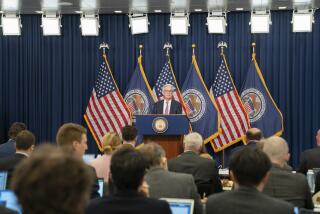Seidman Backs Tough Rules on Bank Lending : Regulations: The FDIC chief wants to reimpose pre-1974 standards on real estate lending. He says their relaxation has been a failure.
- Share via
WASHINGTON — Congress should bar banks from making loans on raw land and insist that developers bear 25% of the cost of real estate projects before they can get bank financing, Federal Deposit Insurance Corp. Chairman L. William Seidman said Thursday.
A return to these tough lending restrictions, which were required by law before 1974, might avert a repetition of the massive real estate losses that have wrecked so many banks in recent years, Seidman told the House Banking, Finance and Urban Affairs Committee.
Banks have been suffering losses from lending practices that “would have been illegal” under the old rules, Seidman noted. But in a series of legislative changes, starting in 1974, Congress eased the strict regulatory controls dealing with real estate lending by banks.
The “mandatory real estate lending rules were repealed,” Seidman said. “The FDIC has been paying the consequences ever since.”
Real estate has become the biggest single source of business for the nation’s banking system and now accounts for 23% of all bank assets.
Although Seidman has long been critical of banks for making imprudent loans, his testimony marked the first time that he has specifically called on Congress to impose tough restrictions on lending practices. He asked legislators to reverse “the course of history in certain areas of bank regulation.”
Under Seidman’s proposal, banks would be limited in the share of business they could devote to real estate lending, in addition to being barred from making loans on raw, undeveloped land. The requirement that builders or developers assume a significant financial share of any projects would encourage more realistic assessments of the projects that they bring to banks for financing, according to Seidman.
The FDIC chairman also repeated his previous insistence that a taxpayer bailout will not be required for the federal insurance fund, which protects bank deposits up to $100,000.
He said his $70-billion plan, which includes borrowing by the fund from the Treasury and from the Federal Reserve system, can be financed with premiums collected from the banking industry.
“The odds are very good that we will not have a taxpayer bailout,” Seidman said, attempting to reassure committee members fearful that Congress will have to mount a rescue for the bank insurance fund as it did for the savings and loan deposit fund.
The plan “does not require taxpayer funding and does not cripple the banking industry,” Seidman said. The temporary borrowing should be adequate to rebuild the fund unless the current recession runs much deeper and lasts much longer than expected, he said. A steep economic decline would drive additional banks into insolvency and make it much harder for the remaining banks to pay the premiums needed to keep the fund healthy.
The current estimates that the banks themselves can generate enough income to keep the insurance fund sound “are largely dependent on future economic conditions,” Seidman said, offering a note of caution. “These conditions have changed in the past and are likely to change in the future. There is no way to see the future.”
Banking Chairman Henry B. Gonzalez (D-Tex.) expressed fears that a bailout by taxpayers may be inevitable. “In a short 18 months, we have gone from rosy predictions of profits for the bank insurance fund to headlines about $70 billion of potential shortfalls in the fund,” he said.
More to Read
Inside the business of entertainment
The Wide Shot brings you news, analysis and insights on everything from streaming wars to production — and what it all means for the future.
You may occasionally receive promotional content from the Los Angeles Times.










